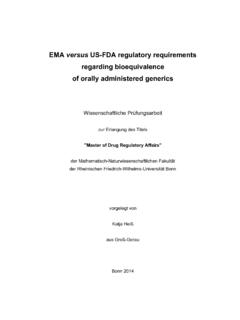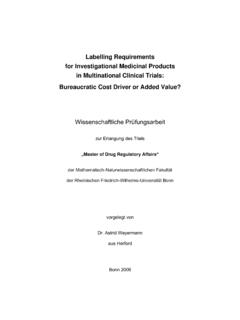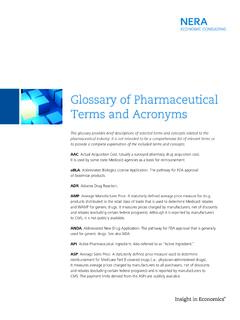Transcription of Basic Requirements For Aseptic Manufacturing Of Sterile ...
1 Basic Requirements For Aseptic Manufacturing Of Sterile Medicinal Products A Comparison Between Europe And USA Wissenschaftliche Pr fungsarbeit zur Erlangung des Titels Master of Drug Regulatory Affairs der Mathematisch-Naturwissenschaftlichen Fakult t der Rheinischen Friedrich-Wilhelms-Universit t Bonn vorgelegt von Dr. Gisela Greger aus Mannheim Bonn 2004 B Betreuer und erster Referent: Frau Dr. Rose Schraitle Zweiter Referent: Herr Wolfram Gering Table of Contents 1 1 1 1 Aseptic 2 Sterility Assurance Level, 2 Parametric 2 3 3 2 ISSUES UNDER 4 APPLICABILITY OF SPECIFICATION OF STERILITY TO pharmaceutical 4 In 4 In the 4 CURRENT GUIDELINES AND RECOMMENDATIONS - 4 SPECIAL ASPECTS IN Aseptic 8 Monitoring at Aseptic Manufacturing Sites - Environmental 8 Clean 8 Room 8 Risk of 10 Monitoring 10 Particle 10 Microbiological 12 Personnel, Training and Entry to Clean 13 Cleaning and 13 Methods of Microbiological 14 Limits and Methods of 14 14 Surfaces (Room, Equipment).
2 15 15 Identification of 17 Evaluation, Limits and 17 Sampling 18 Frequencies of Environmental 18 Incubation of the 20 Measures in Case of Exceeding 20 20 Aim of Environmental Monitoring - 20 Sterilisation 21 Sterilisation by Membrane 21 I Qualification of the Filter: Physical and Chemical Compatibility and Shedding of 21 Extractable Substances .. 22 Adsorption of Substances .. 22 Microbiological Challenge - Bacterial Retaining Rate .. 22 Specification of Filtration Time .. 22 Testing of the Integrity of the Filter .. 23 Support by the Supplier of the 23 Validation of Aseptic Filling Procedure with Media 23 Definition of Media Fill and Requirements of the 23 Microbiological Requirements on Validation of Media 24 Production 24 Environmental Control in Media 24 Air Condition System.
3 26 Qualification of Personnel .. 26 Gas Supply 26 Cleaning and Sterilisation of 26 Necessity of Environmental 26 Extended Environmental Controls Versus Normal Environmental 27 Site Locations .. 27 28 Additional 28 28 28 Qualification and Requalification of Media 29 Media fill and Detection of Specified 29 Cleaning, Heat Sterilisation and Depyrogenization of Container Closure 30 Description of Media 30 Choice of the Media 30 Media Fill and Filling 30 Preparation of Media 30 Worst Case 31 31 Number of Filled Units and Duration of the Filling 31 Duration of Process, Holding Times and Stopping 32 Selection of 32 Acceptance Criteria in Media 32 Warning Limits and Action 32 Action Limits / Procedure in the Case of Failed 33 Incubation 35 Checking of Growth 35 Growth Promoting Properties of the Used Nutrient 36 Overview of Requirements for Referenced Microorganisms in Checking of Growth 37 Inspection of the Filled 40 Identification of Microorganisms from Positive 40 Microbiological Testing in Media Fill - 40 3 RESULTS AND 42 RISK ANALYSIS (HACCP - HAZARD ANALYSIS AND CRITICAL CONTROL POINTS).
4 44 4 CONCLUSION AND 46 5 48 6 49 IVList of Abbreviations ATCC American Type Culture Collection BSE Bovine Spongiform Encephalopathy CDER Center for Drug Evaluation And Research CFR Code of Federal Regulations CFU Colony Forming Units CIP/SIP Cleaning in Place / Sterilisation in Place CPMP Committee for Proprietary Medicinal Products DGHM Deutsche Gesellschaft f r Hygiene Und Mikrobiologie EMEA European Medicines Evaluation Agency EP European Pharmacopoeia EU European Union FDA Food and Drug Administration FIP
5 F d ration Int rnationale Pharmaceutique GMP Good Manufacturing Practice(s) HACCP Hazard Analysis and Critical Control Points HEPA High Efficiency Particulate Air IPC In Process Control ISO International Organisation for Standardisation OOS Out of Specification PDA Parenteral Drug Association Ph. Eur European Pharmacopoeia PIC/S pharmaceutical Inspection Convention QA Quality Assurance QWP Quality Working Party TOC Total Organic Carbon SAL Sterility Assurance Level SOP Standard Operating Procedure US United States USA United States of America USP United States Pharmacopoeia VPHP Vapor-Phase Hydrogen Peroxide WFI Water For Injection 11 Introduction
6 In the early 1900s, the first parenteral drugs were manufactured on an industrial scale. The need arose to find suitable sterilisation methods for heat sensitive products that could not be autoclaved in the final container. So called aseptically manufactured drug products have to be Sterile , although the sterilisation in the final container closure system is not possible. Since then the standards for Aseptic Manufacturing of medicinal drug products have become very high and clearly specified because of the nature of the pharmaceutical form and / or the manner in which they are administered (for example injections, infusions, pharmaceutical forms for the eyes such as eye drops etc.). Parenteral products are intended to be nonpyrogenic too, additionally to the requirement to be Sterile . Medicinal drug products that do not meet the requirement to be Sterile / nonpyrogenic can otherwise cause severe harm or life-threatening health risk to the patient.
7 In a world where global effects in the supply chain become more and more important, it is necessary to know the differences in the Requirements of the specific guidances and guidelines in the single markets of the world. Therefore this master thesis shall reveal the Basic Requirements of Aseptic Manufacturing of Sterile drug products for the EU and US market. Knowledge of the differences in the Requirements is important to guarantee the quality of the products and their supply in due time for the single markets. To begin with, there is a short definition for example of sterility and Aseptic Manufacturing . Following it, is a summary of the Requirements for Aseptic Manufacturing (environmental monitoring, Sterile filtration and validation by media fill) along with the base of these Requirements , keeping in mind the differences between Europe and USA.
8 The outlook will present a rational approach to the complete qualification (rooms, equipment, supply systems, materials etc.) and validation with the help of HACCP (Hazard Analysis and Critical Control Points) concept. Definitions Sterility Sterility1, 2 means the complete absence of any viable microorganism in a drug product . The specification of sterility is unchanging and is independent of the kind of Manufacturing process: sterilisation of the final product in its container closure system or Aseptic Manufacturing . Terminal sterilisation usually involves filling and sealing product containers under high-quality environmental conditions. Products are filled and sealed in this type of environment to minimise the microbiological content of the in-process product and to help ensure that the subsequent sterilisation process is successful.
9 In most cases product , container and closure have low bioburden but they are not Sterile . The product in its final container is then subjected to a sterilisation process such as heat or irradiation. As terminally sterilised drug product undergoes a single sterilisation process in a sealed container thus is limiting the possibilities for error. Aseptic Manufacturing Sterility is best achieved through Sterile filtration of the bulk using a membrane filter ( m or less) in Sterile container closure systems and working in a clean area. Drug product , container, and closure are first subjected to sterilisation methods separately and appropriately. So this is a complex working procedure, which consists of several consecutive and necessary working steps, each of them contributing its part towards the aim of Manufacturing an Aseptic product (prevention of microbial contamination).
10 Any manual or mechanical manipulation of the sterilised drug, components, containers or closures prior to or during Aseptic assembly poses the risk of contamination and thus necessitates careful control. Aseptic Manufacturing is used in cases, where the drug substance is instable against heat, hence sterilisation in the final container closure system is not possible. Aseptic manufacturing1, 2 means that the used drug substance and excipients were sterilised appropriately and all materials, equipment and container closure systems were used only after sterilisation. All working steps were performed in so called clean areas to avoid contamination. Therefore high standards have to be established concerning the Manufacturing room, the personnel, the equipment and the supply systems3, 4, 5 (air system, water for injection, Sterile gases used in the working process; for example compressed air, nitrogen etc.)








